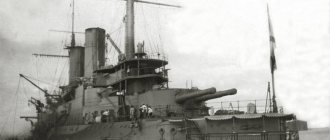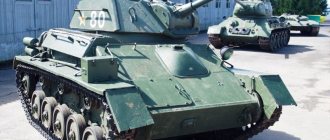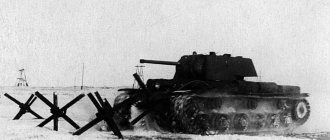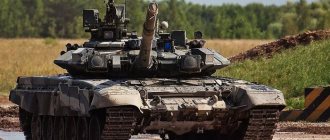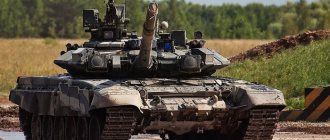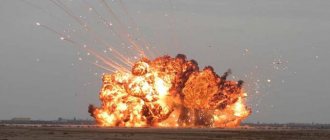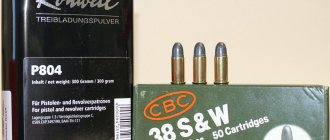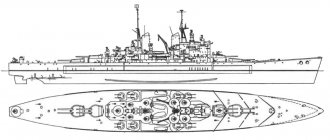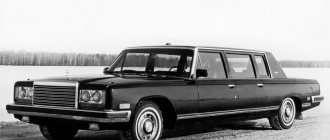Squadron battleships of the Borodino type (FAN)
Home » Alternative shipbuilding - Fleets that never existed » Squadron battleships of the Borodino type (FAN)
Alternative shipbuilding - Fleets that never existedAlternative shipbuilding - Fleets that never existed
arturpraetor 06/30/2016 2476
1
to Favoritesin Favoritesfrom Favorites 1
Battleships of the Borodino class were already initially a controversial topic in the history of the Russian Imperial Navy. Some call them unsuccessful (I met this opinion among Americans), others call them the best battleships of their time. Personally, I am more inclined to the second point of view (with certain reservations), but “Borodintsy” still requires some adjustments. Here colleagues’ opinions may differ - more guns, more armor, more power, but everyone generally agrees that the displacement needs to be increased to 15 thousand tons. Within this framework, I will present my vision of “finishing off” these good armadillos.
Design and construction
"Emperor Alexander III" during completion
After ordering the Tsarevich and Retvizan abroad, the Minister of Maritime Affairs raised an important question with the MTK - what should domestic shipyards do next? And although for now they were still busy with construction, it was necessary to draw up in advance, at least in general terms, a design for future battleships. As a result, in 1898, the design of battleships based on the Peresvet began. As a result, a project was born with an overwhelming number of 152-mm guns - as many as 20 pieces! At the same time, improvements in terms of armor protection were kept to a minimum, and the mine battery was reduced from 20 to 16 75-mm guns. For some time this project was considered the main one, but very soon news came about “Tsesarevich”. Despite certain shortcomings, it had a significant trump card - the location of all 152-mm guns in turrets with wide firing angles and the ability to fire in any weather. The advantage of such installations was also the mechanized supply of projectiles, which did not depend on the fatigue of the servants. Everything was decided quite quickly - the main people in the Maritime Ministry, including Minister Nevsky, spoke in favor of the project. However, the latter also demanded modification of the Tsarevich “to suit the specifics of Russian shipyards”, and in fact - improvement of the French project.
As a result, of the additional 2.5 thousand tons of displacement, most of it went to armor protection. The dimensions of the hull and the power of the power plant were slightly increased, and the contours were also changed according to the results obtained from the Test Pool. Two belts were left, but their height increased significantly, and their thicknesses were redistributed. In fact, battleships became invulnerable to high-explosive shells of all calibers to a height of about 5 meters above the waterline (about half of which had 76-mm anti-fragmentation armor protection), and the entire length of the ship. The defense of the Main Command and SK towers remained serious. In addition, the elevation angles of the guns increased again. For the first time, the latest domestic Geisler control system of the 1900 model was initially included in the design of a rank I ship. The final design was a heavily protected battleship with moderate armament and good seaworthiness. In this form it was approved at the beginning of 1900.
Initially, 3 ships were laid down, and later a 4th was added. All of them were intended for the Pacific Fleet. A little later, it was decided to build 3 more ships - for the Baltic Fleet. “Slava” was laid down according to the original design, and the remaining two were going to be reworked - but the aggravation of relations with Japan and the urgent need for the speedy construction of additional ships led to the construction of “Emperor Paul I” and “St. Andrew the First-Called” according to the original designs. During the process of their completion, they were still planning to rearm them from 12 152/45 mm guns to 6 203/45 mm guns, but the war that had already begun canceled these plans. However, they never had time to take part in hostilities, entering service late, and after them Russia was already building dreadnoughts - as a result, the Russian Imperial Navy never built a single pre-dreadnought.
The construction of the ships was carried out at the usual pace for the Baltic Shipyard and the New Admiralty - entry into service was planned 4 years after the order. However, the Baltic Shipyard managed to speed up the work, and the Emperor Alexander III was the first to enter service. It turned out to be the only battleship of the series that managed to get to the Far East before the start of the war. There she became the flagship ship of the entire fleet and performed well in battles, although she showed her shortcomings to the fullest (at first there were problems with the control system, in fresh weather the ports of the 75-mm guns were flooded with waves, the ship turned out to be very sensitive to overload, causing beyond which stability could drop sharply). The other three battleships formed the core of Skrydlov's squadron, which arrived in the Far East at the beginning of 1905. Three more ships remained on the Baltic Sea. A total of 7 units were built - thus Borodino can be called the largest series of battleships in the history of Russia. They managed to take part in WWII, although they suffered losses. As a result, the 5 ships remaining in service were scrapped after the signing of the Washington Agreement.
"Eagle" shortly before entering service
“Borodino”, Baltic Shipyard, St. Petersburg – 05/11/1900/08/26/1901/03/01/1904
“Emperor Alexander III”, New Admiralty, St. Petersburg – 05/11/1900/07/21/1901/06/10/1903
“Prince Suvorov”, Baltic Shipyard, St. Petersburg – 08/26/1901/09/12/1902/08/27/1904
“Eagle”, New Admiralty, St. Petersburg – 05.20.1900/07.06.1902/10.1904
“Slava”, Baltic Shipyard, St. Petersburg – 10/01/1902/08/29/1903/06/12/1905
“Emperor Paul I”, Baltic Shipyard, St. Petersburg – 09/20/1903/10/07/1904/04/11/1906
“Andrew the First-Called”, New Admiralty, St. Petersburg – 09/20/1903/08/12/1904/07/23/1907
"Prince Suvorov" after entry into service
What are we doing with Borodino?
New armor protection scheme "Borodino"
1) First of all, we increase the displacement - up to 15,516 tons, or exactly by 2000 tons;
2) We increase the dimensions by 10/1 m, which will provide us with an increase in the total displacement while maintaining the draft;
3) The weight of hull structures will increase by approximately +736.7 tons;
4) We add +400 tons to the “Supply” article, bringing its level to the previous “Peresvet”;
5) Add turret reloading compartments for main battery towers - another +50 tons;
6) We bring the coal reserve to 900 tons;
7) We replace the crowd of small-caliber guns with 4 57-mm guns - -16 tons;
 We increase the elevation angle of the artillery - this will give approximately +20 tons of additional weight due to the additional. machine reinforcements;
We increase the elevation angle of the artillery - this will give approximately +20 tons of additional weight due to the additional. machine reinforcements;
9) The displacement reserve increases by +75.3 tons;
10) We simplify the add-ons somewhat;
11) We remove barrage mines - -30 tons;
12) Add +200 hp. power plant, which will cost us +20 tons;
13) The theoretical drawing of the hull changes due to elongation, presumably its characteristics will be close to the Mikasa hull. Thus, the power of the cars is 16,500 hp. will allow you to develop a speed of 18-18.5 knots;
"Emperor Alexander III" during the transition to the Far East, 1903
14) In order to conjure armor protection, you must first bring the old armor to the level of the new hull - i.e. lengthen the belts to the ends by 10 meters. It will cost +59.4 tons;
15) We bring the thickness of the lower belt within the main battery towers to 229 mm, +105.8 tons;
16) We increase the thickness of the upper belt within our “citadel” to the same 229 mm, +192.2 tons;
17) We bring the thickness of the upper belt at the ends to the same thickness of the lower belt, +34.4 tons;
18) We form a complete upper belt, which includes the old armor protection of the casemates of 76 mm guns - +240 tons;
19) In total, we get a completely new armor protection scheme - a lower full belt (including the old two) with a thickness of 127-229 mm and a height of 3.34 meters, and an upper full belt with a thickness of 76 mm and a height of 2.3 m. Now you don’t have to be afraid of landmines at all , even if you overload the battleships with coal.
1st edit
20) Still, the upper 76 mm belt is clearly superfluous, as my colleague mangust-lis . We remove it - we have 240 tons of displacement for maneuvers.
21) We increase the thickness of our main (and now only) belt by 25 mm, or one inch. This will cost approximately 185.1 tons;
22) We increase the thickness of the armor protection of the casemates of 75 mm guns by the same inch, to 102 mm. This will cost approximately 54.9 tons.
As a result, we completely and accurately exhaust our “free” displacement.
2nd edit
23) Colleague Andrey pointed out that I was starting from erroneous sources in determining the thickness and design of armor protection. In addition, I also started from a greatly “underloaded” normal displacement of 13,516 tons, whereas during construction overload it was around 14,440 tons. To summarize all this, it is necessary to recalculate the armor protection loads and lighten the overall structure by 500 tons (without construction overload, the Borodino would have weighed around 14 thousand tons). All further calculations are approximate, because they will be carried out in isolation from my sources.
24) We cancel all witchcraft of the 1st edit - -240 tons;
25) Partially reduce the thickness of the 229 mm section of the main belt to 178 mm. This will cost approximately 91 tons;
26) It remains to decide how much lighter the version of armor protection that I made will be in relation to the actual thickness of the lower belt of the Borodino. To do this, I’ll take Suliga’s diagram, which I based on, and the thickness of the belt indicated by my colleague Andrey . Don’t forget that the Borodino frame has a spacing of 1.2 meters (real armor protection is given based on the frames). In total, it turns out that I had a reserve for maneuvers of 28 tons;
27) “I made you bigger, I’ll make you smaller!” Coal reserves are reduced by 69 tons.
28) We take another 22 tons from the displacement reserve. Good. I already had it somewhere around 2.2 percent.
29) And we brazenly make up for the remaining 50 tons at the expense of supplies (which I previously had in the region of 600-650 tons).
As a result, errors in the armor protection scheme were taken into account, and the entire structure was lightened by 500 tons. Those. we have the same 15,516 tons, but this time coming from the correct weight distribution.
Tactical and technical characteristics of squadron battleships of the Borodino type
"Emperor Alexander III" in typical Pacific Fleet livery, 1904
Displacement: 15,516 tons
Dimensions: 128.8x24.22x7.97 m
Mechanisms: 2 shafts, 2 PM VTR, 20 Belleville boilers, 16,500 hp. = 18.5 knots
Fuel capacity: 831/1300 tons of coal
Range: 3650 miles (10 knots)
Armor (krupp): lower belt 127-229 mm, casemates 76 mm, main gun turrets 254 mm, main gun turret roofs 63 mm, barbettes 102-254 mm, SK turrets 152 mm, SK turret roofs 30 mm, SK 127 mm barbettes, bulkheads 51 mm, deckhouse 203 mm, casings KO 19 mm, anti-tank gun 43 mm, decks 25-51 mm
Armament: 4 305/40 mm, 12 152/45 mm, 20 75/50 mm, 4 57/50 mm guns, 5 381 mm torpedo tubes
Crew: 27/744 people
"Slava" in standard ball paint, Baltic Fleet, 1914
The weight distribution table, alas, became a victim of the dying HDD, so this article will do without it.
Notes
1) I am still experiencing certain difficulties with posting articles due to problems, among which the most important one so far is the rapidly dying HDD (a new one is on the way, and it will be unknown when). For the most part, the work was saved, but the weight distribution tables and some of the drawings will have to be restored from scratch.
2) I understand that the decision to build Borodintsev further and move to dreadnoughts without intermediate ships is doubtful, but for me it is completely justified. Moreover, I plan to start building dreadnoughts in 1906 (even before the Dreadnought goes into operation).
3) Special thanks to my colleague Atenaia , who confirmed my doubts about “somehow the Borodino did not accelerate well with such a powerful power plant.” Without it, the battleship would have been left with three thinner belts and a power plant with a power of 19,000 hp. (and speeds 18-18.2 knots);
4) A slight panic begins about the dreadnoughts. I can’t decide which option to choose—with linearly elevated towers or linear ones. There is essentially only one argument against the latter - weak pursuit and retreat fire. If not for this, there would be no hesitation.
Fire control system
SUAO mod.1899. The set of instruments was first presented at an exhibition in Paris in 1899 and was installed on many RIF battleships. It was the prototype of modern central guidance systems. The basis of the system was two sighting posts (VP) - one per side. Pancratic, optical, monocular devices of these posts - central aiming sights (VCN) had a variable magnification factor - 3x-4x. The search for the target and pointing the weapon at it was carried out by the VP operator. When pointing the VCN at a target, the elevation angle of the target relative to the centerline plane of the ship was determined on a scale, and the tracking system associated with it automatically set this angle with an arrow in the receiving instruments of the main 8 turret guns and batteries of the ship's 75mm guns. After this, the gunner-operators (commanders) carried out horizontal aiming of their installations until the angle of rotation of the gun was aligned with the elevation angle of the target (the so-called “arrow alignment” principle) and the target fell into the field of view of the gun optical sights. Optical, pancratic, monocular sights of the Perepelkin system had a variable magnification factor - 3x-4x and a field of view angle changing in accordance with it - 6 - 8 degrees. To illuminate the target in the dark, six combat searchlights with a mirror diameter of 750 mm were used. The next step was to determine the distance to the target. For this purpose, there were two rangefinder stations in the conning tower - one per side. They were equipped with horizontal base rangefinders “Barr and Studd” with a base of 1200mm. The rangefinder measured the distance and, using the rangefinder key, the data was automatically entered into the receiving devices of the conning tower, central post, 8 main turret guns and batteries of 75mm guns. To monitor the correctness of data transmission, there was a feedback system with a control rangefinder dial, the readings of which were compared with those entered into the receiving devices. A set of instruments and a magnetic compass in the conning tower showed the senior artillery officer his own course and speed, direction and strength of the wind. He determined the course and speed of the target approximately “by eye.” Having data on his own speed and heading, wind direction and strength, deviation, type of target, target elevation angle and distance to it, estimating the approximate speed and heading of the target, the senior artillery officer, using firing tables, made the necessary calculations manually (on paper) and calculated the necessary corrections for the leads for VN and GN. I also chose the type of gun and the type of shells needed to hit a given target. After this, the senior artillery officer transmitted guidance data to the control unit, from which he intended to hit the target. For this purpose, in the conning tower and the central post there was a set of master indicator devices, which transmitted data through 47 cable cores to receiving devices in the AC and 75mm batteries. The entire system operated at voltage Uр=23V through a 105/23V transformer (DC?). In the case of centralized fire control, they transmitted data on vertical and horizontal guidance angles and the type of projectiles used. After receiving the necessary data, the gunners-operators of the selected guns installed the guns at specified angles (corrected the initial installation according to the VCN) and loaded them with the selected type of ammunition. After performing this operation, the senior artillery officer, who was in the conning tower at the moment when the inclinometer showed “0”, positioned the handle of the fire indicator device in the sector corresponding to the selected fire mode “Shot”, “Attack” or “Short alarm”, in accordance with which The guns opened fire. This centralized fire control mode was the most effective. In the event of the failure of the senior artillery officer or the impossibility for any other reason to carry out centralized fire control, all 305mm, 152mm artillery guns and a battery of 75mm guns switched to group (plutong) or single fire. In this case, the instruments transmitted data about their course, their speed, the direction and strength of the wind, the elevation angle of the target, and the distance to it, but all calculations were made by the commander of the artillery unit or battery. This fire mode was less effective. In the event of complete destruction of fire control devices, conning tower personnel and data transmission circuits, all guns switched to independent fire. In this case, the selection of a target and targeting it was carried out by calculating a specific gun using only a gun optical sight, which sharply limited its effectiveness and range. The torpedo tubes were aimed using ring sights with the same tracking system as the VP for onboard 381mm torpedo tubes or by turning the entire hull of the vessel for the new and aft 381mm torpedo tubes. It should also be noted that the officers and gunners of the Russian squadron battleships of the 2nd Pacific Squadron poorly mastered this system and used its capabilities far from fully.
List of ship and staff officers killed in the Battle of Tsushima
- Flag Quartermaster Captain 2nd Rank Alexander Gustavovich von-Witte
- Commander Captain 1st Rank Pyotr Iosifovich Serebryannikov 1st
- Senior officer Captain 2nd rank Dmitry Sergeevich Makarov 2nd
- Inspector Midshipman Nikolai Oskarovich Ott 1st
- Senior mine officer Lieutenant Alexey Fedorovich Gerken 1st
- Junior mine officer Lieutenant Vladimir Titovich Matkovsky
- Senior artillery officer Lieutenant Pyotr Evgenievich Zavalishin 2nd
- Junior artillery officer Lieutenant Mikhail Eduardovich Fuks
- Junior artillery officer Lieutenant Evdokim Ivanovich Yakovlev 5th
- Senior Navigation Officer Lieutenant Boris Illarionovich Tchaikovsky 1st
- Junior Navigation Officer Midshipman Konstantin Rudolfovich De Livron 4th
- Watch Chief Lieutenant Alexey Pavlovich Prince Enikeev
- Watch Chief Midshipman Mikhail Aleksandrovich Taranetsky
- Watch Chief Midshipman Georgy Mikhailovich Zholkevich
- Watch officer Midshipman Nikolai Nikolaevich Prikot
- Watch officer Midshipman Nikolai Aleksandrovich Protasyev
- Watch officer Midshipman Evgeniy Genrikhovich Tsivinsky 2nd
- Watch officer Midshipman Alexander Viktorovich Kochukov
- Watch officer Lieutenant of the Life Guards Hussar Regiment Leonty Pavlovich Count Bennigsen
- Watch officer Ensign for the naval unit Boris Vladimirovich Nedzvetsky
- Senior ship mechanic Lieutenant Colonel KIM Vasily Semenovich Ryabinin
- Bilge mechanic Staff-Captain KIM Vladimir Konstantinovich Nyukhalov
- Ship mechanic Staff-Captain KIM Pavel Pavlovich Korneev
- Ship mechanic Lieutenant KIM Pavel Mikhailovich York
- Ship mechanic Lieutenant KIM Ernest Nikolaevich Wulf
- Junior ship mechanic Lieutenant KIM Vladimir Georgievich Kharitonov
- Junior ship mechanic Ensign for fur. parts Nikolay Stepanovich Pevnev
- Junior ship mechanic Ensign for fur. parts Ivan Ivanovich Dzakhov
- Senior ship's doctor Nadvorny Advisor Fedor Mikhailovich Lukin
- Junior ship's doctor Doctor Aksel Eduardovich Gnadeberg
- Naval Engineer Junior Assistant Shipbuilder Diodor Mikhailovich Shangin
- Ship priest Hieromonk Father Varlaam
- Bandmaster Pavel Novikov
